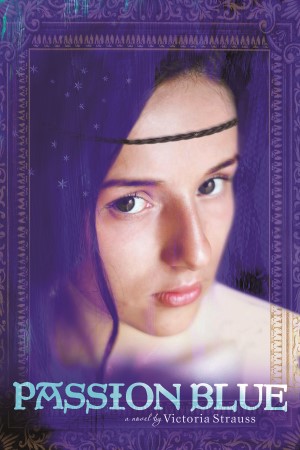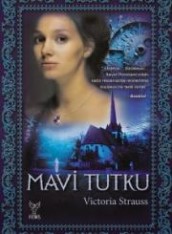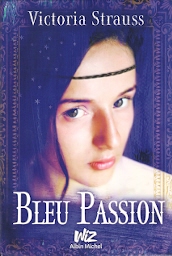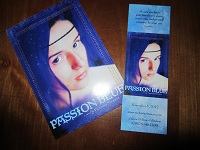Passion Blue
Book 1 of the Passion Blue duology
Skyscape, 2012
ISBN: 978-0761462309
Hardcover: $17.99
Paperback: $9.99
Ebook: $9.99
Order: Amazon / Barnes & Noble / Chapters/Indigo / IndieBound
Be sure you know your true heart’s desire, or you may find yourself surprised by what you receive.
This is the warning the Astrologer-Sorcerer gives Giulia when she pays him to create a magical talisman for her. The scorned illegitimate daughter of a Milanese nobleman, Giulia is determined to defy the dire fate predicted by her horoscope, and use the talisman to claim what she believes is her heart’s desire: true love and a place where she belongs–not likely prospects for a girl about to be packed off to the cloistered world of a convent.
But the convent of Santa Marta is full of surprises. There are strict rules, long hours of work, and spiteful rivalries…but there’s also friendship, and the biggest surprise of all: a workshop of female artists who produce paintings of astonishing beauty, using a luminous blue mixed from a secret formula: Passion blue. Yet as Giulia begins to learn the mysteries of the painter’s craft, a forbidden romance beckons her down a path of uncertainty and danger. She is haunted by the sorcerer’s warning, and by a question: does she really know the true compass of her heart?
Set in Renaissance Italy, this richly imagined novel about a girl’s daring journey towards self-discovery transports readers into a fascinating, exotic world where love, faith, and art inspire passion–of many different hues.
Scroll down for an excerpt, or download the first two chapters
Check out Book 2: Color Song
PRAISE
Fantasy elements and a historical setting rich with sensuous detail are satisfying, but it’s Giulia’s achingly real search for her heart’s desire that resonates most today, when millions of girls still have limited choices. A rare, rewarding, sumptuous exploration of artistic passion.
– Kirkus (starred review, editor’s pick for Fall 2012, a Best Teen Book of 2012) –
Teens will truly relate to Giulia’s struggle to do what is right and still have her way in a world that presents on-going challenges, danger, betrayal, and finally, enlightenment.
– VOYA (highlighted review) –
Vividly set during the 15th-century Italian Renaissance, Strauss’s novel has a strong and thoroughly likable heroine who is only one of many well-developed female characters.
– School Library Journal –
Strauss (Guardian of the Hills) takes great care to illustrate Giulia’s complicated world fully, including the limited choices available to women during the Renaissance, convent life, and painting techniques of the time….Giulia’s unusual story is sure to capture readers’ attention.
– Publishers Weekly –
[C]ompelling…absorbing…An intriguing historical novel inspired by accounts of women artists in the Italian Renaissance.
– Booklist –
Giulia’s soul-searching, a budding first love, fragile friendships, the introduction of several villains, deception, and harrowing escapes work to create a compelling story that is hard to put down.
– Children’s Literature –
[A] thoughtful and engrossing exploration of what true “freedom” might have meant for a woman with talent and ambition in sixteenth-century Italy.
– Bulletin of the Center for Children’s Books –
Strauss’s depiction of fifteenth-century Milan employs a wealth of historical details, smoothly interwoven with magical elements and a compelling protagonist.
– The Horn Book –
I am a huge fancier of historical novels, so when I began Passion Blue, set in late fifteenth century Italy, I expected to like it…But I don’t just like the book, I love it. Though much of it takes place within the walls of a nunnery it has adventure, arguments, soul-searching, several villains, romance, hair-breadth escapes, dastardly betrayals, and girl power. I simply galloped through it.
– Jane Yolen, author of The Devil’s Arithmetic, Briar Rose, and other novels set in historic periods –
Strauss combines the spiritual with a hint of the supernatural to tell a story about a girl’s journey to both freedom and passion. A lovely read.
– Megan Whalen Turner, author of The Queen’s Thief series –
An elegant retelling of that old, crucial story of finding one’s place in the world, set against a vivid evocation of the Italian Renaissance.
– Robin McKinley, author of Beauty –
In Passion Blue, Victoria Strauss provides a glimpse of 15th century Italian life as sure-handed and brilliantly illuminated as the work of a Renaissance master….Intelligent, inexperienced, and badly wronged, Giulia is a heroine we can all root for. From its opening chapter to its final harrowing unfolding, her tale holds the reader riveted. Passion Blue is both a soul-felt journey and a triumphant work of art.
– Meredith Ann Pierce, author of the Darkangel Trilogy –
Passion Blue is a lush, vibrant read that is utterly transporting. Full of heart and heady imagery, it is a luminous tale that swept me back to another time and place and into the life of a brave girl struggling to find her true destiny.
– Lesley Livingston, author of the Wondrous Strange series
Passion Blue opens a rich window into Renaissance Italy, portraying a determined heroine’s struggle to fulfill her artistic gift in defiance of the limitations of her time….A very enjoyable read.
– Robin Hobb, author of the Farseer Trilogy –
SWAG!
I have bookmarks and postcards!
If you’d like one or both, send a stamped, self-addressed envelope to PO Box 1216, Amherst MA 01004.
Let me know if you’d like them signed.
EXCERPT
The afternoon was almost gone by the time Giulia reached the sorcerer’s house.
She’d known where Porta Orientale was, at least in theory–Maestro had showed her plans of Milan, with its six districts, or porte, arranged like pie slices around the central piazza that housed the Duomo, the city’s vast cathedral. But finding her way through the streets was not the same as poring over maps. She’d quickly become lost, and the conflicting directions she had begged from passersby had taken her far out of her way. She’d begun to worry that she would still be wandering the city when night fell, at the mercy of cutpurses or worse.
But finally, like a miracle, there it was–a pillar painted with seven stilettos, marking the entrance to the Via Sette Coltelli, the Street of Seven Knives.
The sorcerer’s house was protected by a stucco wall. An iron gate allowed glimpses of a garden full of overgrown yews and cypresses, through whose twisted branches Giulia could just see the house itself. Perhaps because of all the heavy vegetation, the garden seemed much darker than the avenue outside, as if night had already fallen there. A bell rope hung beside the gate.
Giulia had wondered what a sorcerer’s home might look like. This gloomy place fulfilled all her expectations.
For just a moment, the fear she’d fought as she trudged the city rose up and overwhelmed her, and Maestro’s words of warning sounded in her mind. She pushed them away. I’ve come this far. I cannot turn back.
She drew a deep breath. She stepped forward and rang the bell.
Clang. The sound echoed back into the shadowed garden. For a long moment nothing happened. Then she heard a creak, as of a door opening, and saw someone coming toward her–a woman, bent with age, her head wrapped in a kerchief. The woman shuffled up to the gates and peered through the bars.
“What d’you want?”
“I’ve come–” Giulia cleared her throat. “I’ve come to see Maestro Francisco Barbaro, the sor–the astrologer. It’s urgent.”
“It always is. Can you pay?”
“Yes.”
The crone lifted the bar that secured the gates. She dragged at one of them, pulling it back a little way. “Well?” Impatiently, she beckoned. “Don’t be all day.”
Giulia slipped through the narrow gap. The crone heaved the gate closed and reset the bar, then led the way along the wide stone path that split the tangled garden, beneath the dimness of the trees. She hurried Giulia through the house’s great oaken door and down a magnificent candle-lit corridor whose elaborate frescos and polished marble were the very opposite of the garden’s neglect. An enormous, high-ceilinged room lay at the corridor’s end.
“Wait here,” the crone instructed, pointing to a spot by the door. “I’ll see if he’ll receive you. He may not. He doesn’t see everyone.”
She hurried toward the room’s other side, where a curtain hung across an opening.
“Tell him Maestro Carlo Bruni gave me his name,” Giulia called after her. “They were friends once.”
The old woman gave no sign that she had heard. She lifted the curtain and vanished.
The blue-gray twilight admitted by the windows did little to relieve the chamber’s gloom. Her back against the door, her teeth chattering with chill and fright, Giulia could almost imagine that the old woman had been a ghost, that there were no living beings in this place besides herself. For courage, she rested her hand on her mother’s topaz necklace, hidden under the neck of her gown.
The curtain swept aside. A man came through, clad in a flowing robe and carrying a branch of candles.
“You say you come from Carlo Bruni, girl?”
Giulia had to try twice to find her voice. “Yes, sir.”
“Who are you?” The sorcerer approached, holding up the candles. “Why has he sent you?”
“My name is Giulia, sir. I’m his pupil.”
“His pupil?” He sounded skeptical.
“Yes, sir. And he didn’t send me. That is, he told me your name…but I’m here…I’m here on my own.”
“Ah.”
Was it disappointment in his voice? He set the candles on a table and began to move around the room, lighting more candles in sconces on the walls. Giulia couldn’t tell how he accomplished this–it looked as if the flame sprang directly from his fingers. The rising illumination revealed the magnificent zodiac wheel inlaid upon the marble floor, showing the twelve signs, their associated houses, and their ruling planets. As the candle flames flared up, points of light seemed to kindle on the ceiling as well. With astonishment, Giulia recognized the zodiac constellations, arranged in a ring that exactly matched the circle on the floor. Awed, she gazed upward. Scorpio glittered directly overhead; to the left was Pisces, under which she had been born.
“Carlo Bruni and I were friends, years ago.”
The sorcerer stood before her. She had imagined someone crabbed and stooped, made ugly by his outlaw pursuits, but this man was well-formed and straight, with a handsome face and large, calm eyes of crystalline blue. The silk of his robe was a deeper blue. His hair was entirely covered by a close-fitting cap that appeared, strangely, to be made of polished metal.
“The best of friends,” he continued. “Did he tell you that?”
Giulia nodded. She’d assumed that Maestro and the sorcerer were of an age, but this man looked at least twenty years younger. She felt a thrill of fear. If he can light candles with his fingers and make stars shine on his ceiling, what else can he do?
“Did he tell you why we are friends no longer?”
“He said you quarreled, sir.”
“It was the magic. It destroyed our friendship. When I heard you were here, I thought–” The sorcerer paused. “No matter. I was angry when we parted, but I’ve come to understand the choice he made. Will you tell him that for me?”
“Yes, sir,” Giulia said, though she knew that if she ever saw Maestro again, she could never admit she had come here.
Want more? Download the first two chapters
And be sure to check out Color Song, the followup to Passion Blue
LEFT ON THE CUTTING ROOM FLOOR…
Prologue: Passion Blue originally had a prologue, which showed how Giulia’s mother obtained the horoscope that’s so important to Giulia’s story. In the process of editing the prologue (as well as a lot of other stuff!) wound up being deleted.
Original Chapter 1: The first draft of Passion Blue began much earlier–with Giulia’s childhood, and a chapter in which she and her mother look at the precious horoscope and talk about Giulia’s future. But on the theory that a book should start as close as possible to the event that triggers the story, my editor and I decided to cut this chapter and incorporate the backstory elsewhere.





